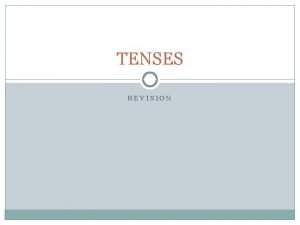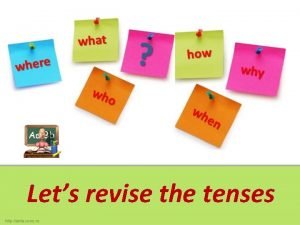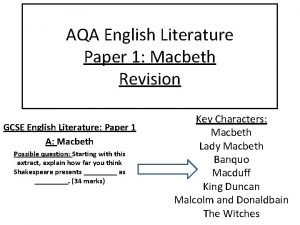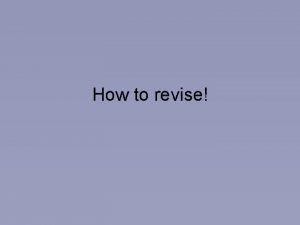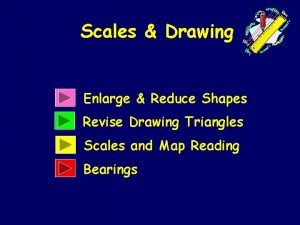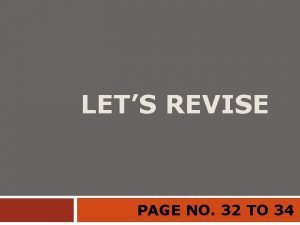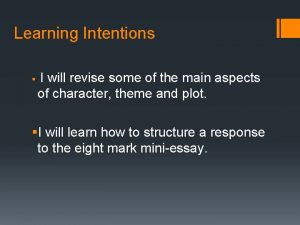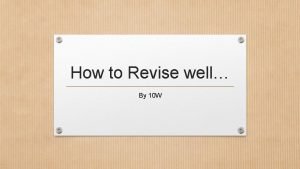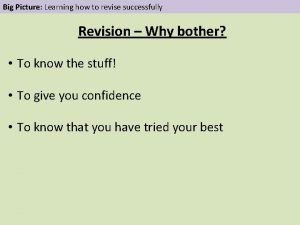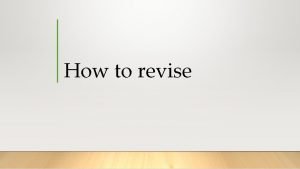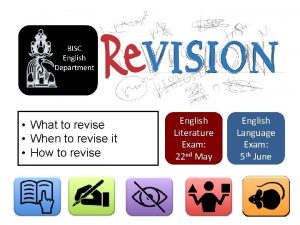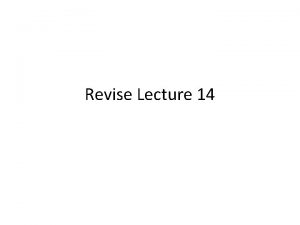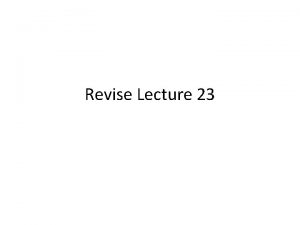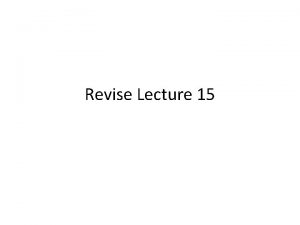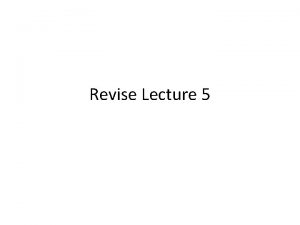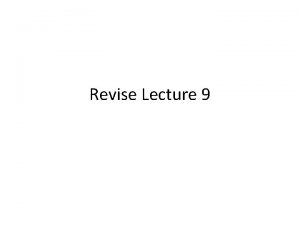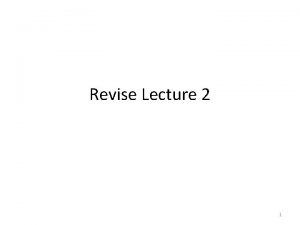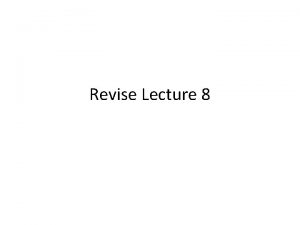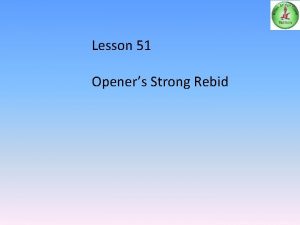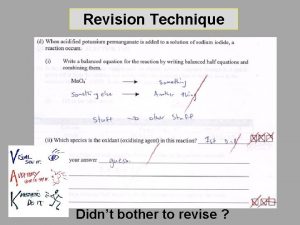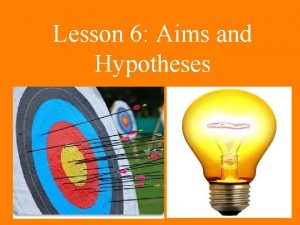LESSON AIMS FOR UNIT To revise the National

















































- Slides: 49


LESSON AIMS FOR UNIT To revise the National 5 20 th Century concepts and to learn the new higher concepts from 20 th Century.

SUCCESS CRITERIA FOR UNIT I can identify from my existing knowledge the National 5 20 th Century concepts through listening to excerpts of music I can explain and identify the new higher 20 th Century concepts through listening to excerpts of music.

Using a show me board/or a piece of paper write down the 20 th Century concepts you already know!

What Did You Miss BLUES JAZZ RAGTIME SWING MINIMALIST L A N O T A DISCORD IMPRESSIONISM N IMPROVISATIO SCAT SIN G S S A B G N I K L WA ING SYNCOPA TION POP CLUSTER GOSPE L IC T L CE RIFF K C O R ROCK REVERB

• • A style of dance music which became popular at the end of the 19 th century Helped to influence jazz. Often heard on the piano Syncopation in the right hand has a vamped accompaniment in the left hand. Listen to “The Entertainer” a famous piece of music by Scott Joplin! Listen out for the VAMP and the SYNCOPATION

• At first this was music created by black Americans in the early 20 th century. • Features of the music may include syncopation and improvisation. Listen to this piece of Jazz music and answer the following questions. 1. Write down what concept best describes the technique used by the female singer/ 2. Name the two instruments you can hear IMPROVISING. 3. Identify another 2 concepts that you hear.

• Blues started as Black American folk music, developing from spirituals and work songs. • Blues music often has 4 beats in a bar and is mostly patterned on a 12 -bar structure and on a scale where some notes are flattened. • Due to its origins in slavery, blues music tends to have a sadness to it. Listen to Muddy Waters and identify THREE concepts that you hear in the music.

• A jazz style which started in the 1930 s and was performed by a big band. • The numbers and types of instruments in the big bands increased during this period, through the influence of swing. Listen to this piece of Swing music by Glen Miller. Write down the instruments that you can hear!


Listening Activity 1 This question features different styles of music. Listen to the following excerpt and tick one box to describe what you hear. Blues Swing Ragtime Jazz

Question 1 b Listen to the following excerpt and tick one box to describe what you hear. Blues Swing Ragtime Jazz

Question 1 c You will hear an excerpt of instrumental music. You should insert the missing information in each of the four areas. A voice will guide you through the first two playings. There is no voice in the third playing. 1. 2. 3. 4. The tonality is There are The solo instrument is a/an This style of music is called ____________ beats in the bar.

Question 1 d You will hear an excerpt of vocal music. You should insert the missing information in each of the four areas. A voice will guide you through the first two playings. There is no voice in the third playing. 1. 2. 3. 4. The solo voice is a/an The trumpet is playing The technique used by the vocalist is _____ This style of music is called ______ (Italian term) _____

• Based on simple rhythmic and melodic figures which are constantly repeated with very slight changes each time. Famous composers are Steve Reich and John Cage.

Steve Reich • Clapping Music (1972) two musicians clapping


The Power is in Your hands Challenge 1. Split into pairs (where possible) 2. You are going to number yourself 1 and 2 3. You are going to clap the rhythms on the following page following your own part 4. Each number must be clapped TWICE before moving on.

Remember to repeat each one before moving onto the next number 1 + 2 + 3 + 4 + 5 + 6 +

Music written with religious lyrics, often in praise or thanksgiving to God. Gospel has its origins in Afro-American culture. Listen and watch an example of gospel music on the next slide. Identify THREE concepts that you hear in the music.

Click below to watch video!


Listening Activity 2 This question features instrumental music. a) As you listen to the excerpt. i) Tick one box to describe the style of music, and ii) In the space below , give reason to support your answer Blues Gospel Ragtime Minimalism Reason _________________

Question 2 b b) As you listen to different excerpt. i) Tick one box to describe the style of music, and ii) In the space below , give reason to support your answer Blues Gospel Ragtime Minimalism Reason _________________

IMPRESSIONIST SOUL MUSIC JAZZ FUNK MUSIQUE CONCRETE TIME CHANGES IRREGULAR METRES

Composers became much more experimental and tried to find ways of music-making that had not been tried before. One of the best examples of this is 4’ 33’’ by John Cage Let’s watch it! http: //www. youtube. com/watch? v=JTEFKFi. XSx 4

Lets find out what else changed

CHROMATIC WIDE LEAPS GLISSANDO DISSONANT INTERVALS

DISCORDS = NOTE CLUSTERS EXTREME DISSONANCE

7 8 3 5 2 4 SYNCOPATION TIME CHANGES IRREGULAR METRES POLYRHYTHMS

Strange and exotic sounds Instruments played at the extremes of pitch range New sounds created using equipment such as magnetic tape. Using instruments in unusual ways to create sound (e. g. bowing stringed instruments behind the bridge) muted brass effects

IMPRESSIONISM Impressionism is a term that describes a period (roughly 1890 to 1930) throughout the arts, where the main objective was to suggest the idea of something rather than to give a detailed description of it. Sunrise by Monet The impressionist method was originally inspired by paintings by French artists, such as Monet.

What to expect from IMPRESSIONISM o Melodic –Use of scales such as whole-tone, pentatonic, modal & chromatic. o Harmonic -Discords (often 9 th or 13 th) in parallel motion. o Rhythmic -Often vague, fluid rhythms, no clear sense of pulse. o Style/Form -Often programmatic or descriptive Listen to the famous “La Mer” by Debussy and identify FOUR concepts that you hear.

A prominent feature in Impressionist music is the whole tone scale Using a keyboard play this example of a whole tone scale.

Claude Debussy Born in France in 1862. His most famous work is L’apres-midi d’un faune. “Modern music awakes with Debussy’s L’Apres-midi d’un faune”. Listen for - the WHOLE TONE SCALE, and DISSONANCE.

Listening Activity Listen to L’apres-midi d’un faune. In your groups, write down as many concepts as you can that you hear in the music. WHOLE TONE SCALE & DISSONANCE

Musique Concrete Recorded natural sounds which are transformed using simple editing techniques such as cutting and re-assembling, playing backwards, slowing down and speeding up. Pierre Schaeffer composed the first piece of musique concrete in 1948. He recorded, manipulated and arranged a variety of sounds produced by trains. Now have a listen to this famous piece of music called Etude aux Chemins de Fer. Give one word to describe what you hear.

A combination of jazz improvisation and the amplified instruments and character of Rock. Usually has a synthesiser Slap Bass was very popular in Jazz funk music – a technique where bass guitarist Use their thumb to pull and slap the strings Listen to a piece of Jazz Funk music and identify TWO concepts that you hear.

A style of Afro-American popular music including elements of blues and gospel and conveying strong emotions. Listen to this piece of Soul music. Write down the instruments that you can hear!

TIME CHANGES When the time signature changes in the same piece of music.

IRREGULAR METRES When you can have different groupings of notes as there isn’t an equal number for instance 5 5 7 7 See the examples below. 8 4 There are 7 quaver beats in this time signature and they can be grouped in 3 quavers and 4 quavers as shown above. Here is another example of 7/8. There are still 7 quaver beats in this time signature however the grouping of the notes has changed to 3 quavers then two groups of 2 quavers.

Listen to a piece of music that contains irregular metres. Your challenge is to work out how many beats are in the bar!


Listening Activity 3 Q 3 a. i) This question features instrumental music. Listen to this excerpt and identify three concepts in the music from those listed below. Con Sordino Impressionism Augmentation Minimalism Rubato Syncopation Immitation Whole Tone Scale Obbligato Romantic Give your answers on the line below. Impressionism, Whole tone scale, Rubato ________________________

3 a) ii) Listen to a different excerpt, which will be played twice, and identify the style of music. Jazz Funk b) Listen to a new excerpt, which will be played twice, and concept which describes the time signature. Irregular Metres

Q 4. This question features instrumental music. Listen to this excerpt and identify FOUR concepts in the music from those listed below. Alberti bass Musique Concrete Whole-tone scale Minimalism Three against two Acciaccatura Jazz - Funk Rubato Middle eight Exposition Give your answers on the line below. Three against two, Middle eight, Acciaccatura, Rubato ________________________

Q 5 a) Listen to this excerpt and identify the final cadence. The music will be played twice. Plagal Here is the music for the first time. Here is the music for the second time. Q 5 b) Listen to this excerpt and identify the concept that best describes the time signature. The music will be played twice. Irregular metres Here is the music for the first time. Here is the music for the second time.

Question 6 You now have to answer questions relating to the music printed below. Listen to the excerpt and follow the music. Do not attempt to write during this playing. Here is the music. The music will be played three more times with a pause of 30 seconds between playings. After the final playing you will have 2 minutes in which to complete your answers. A warning tone will sound 30 seconds before the next question starts. Here is the music for the first time. Here is the music for the second time. Here is the music for the third time.

1. Write the time signature of the music in the appropriate place. 2. Write the concept which best describes the piano part during this excerpt. Countermelody/improvisation 3. Mark with a bracket the first example of an interval of a semitone.
 Revision present simple
Revision present simple Response
Response Present simple remember
Present simple remember How to revise english literature
How to revise english literature Reject and resubmit
Reject and resubmit Assure model lesson plan physical education
Assure model lesson plan physical education English literature paper 1 macbeth
English literature paper 1 macbeth Positive discriminating power
Positive discriminating power What is unstructured questionnaire
What is unstructured questionnaire How to revise and remember
How to revise and remember What does revise mean
What does revise mean How to revise effectively
How to revise effectively Lets revise
Lets revise Helping students revise knowledge
Helping students revise knowledge Youre goals
Youre goals Judith murciano
Judith murciano How to revise for english language
How to revise for english language How long should i revise for
How long should i revise for I dont know how to revise
I dont know how to revise Revise and editing
Revise and editing Revise drawing
Revise drawing Lets revise
Lets revise I will revise
I will revise Prefix meaning of dis
Prefix meaning of dis Revise well
Revise well Revise picture
Revise picture Right triangle trigonometry examples
Right triangle trigonometry examples Unit 10, unit 10 review tests, unit 10 general test
Unit 10, unit 10 review tests, unit 10 general test Fspos vägledning för kontinuitetshantering
Fspos vägledning för kontinuitetshantering Typiska drag för en novell
Typiska drag för en novell Tack för att ni lyssnade bild
Tack för att ni lyssnade bild Returpilarna
Returpilarna Shingelfrisyren
Shingelfrisyren En lathund för arbete med kontinuitetshantering
En lathund för arbete med kontinuitetshantering Kassaregister ideell förening
Kassaregister ideell förening Vilotidsbok
Vilotidsbok Anatomi organ reproduksi
Anatomi organ reproduksi Vad är densitet
Vad är densitet Datorkunskap för nybörjare
Datorkunskap för nybörjare Boverket ka
Boverket ka Tes debattartikel
Tes debattartikel För och nackdelar med firo
För och nackdelar med firo Nyckelkompetenser för livslångt lärande
Nyckelkompetenser för livslångt lärande Påbyggnader för flakfordon
Påbyggnader för flakfordon Lufttryck formel
Lufttryck formel Svenskt ramverk för digital samverkan
Svenskt ramverk för digital samverkan Urban torhamn
Urban torhamn Presentera för publik crossboss
Presentera för publik crossboss Jiddisch
Jiddisch Plats för toran ark
Plats för toran ark
